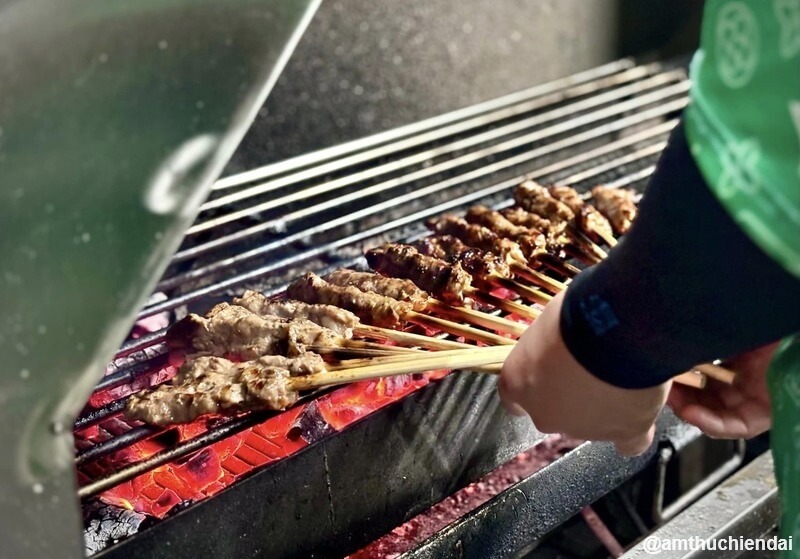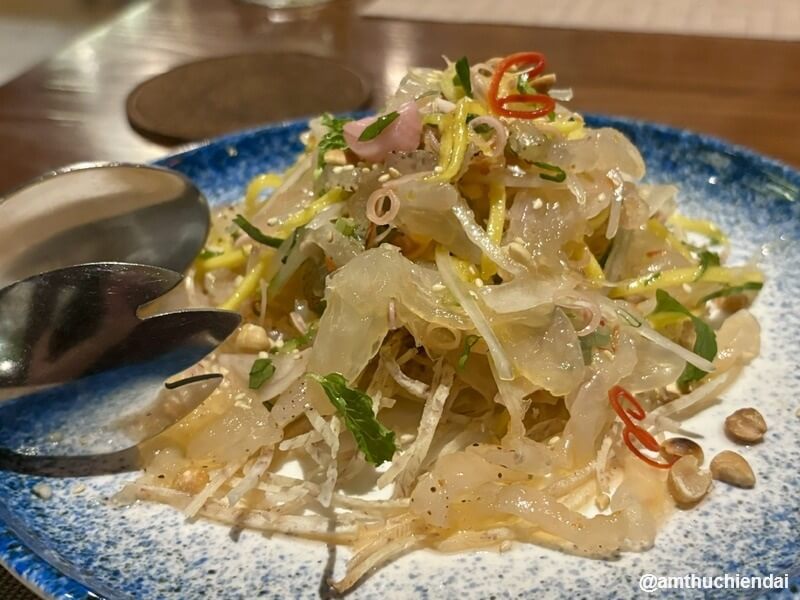Many people believe that you cannot associate Vietnamese food with wine.
While it’s true that this isn’t a traditional pairing, Vietnamese food has traveled to countries with strong wine cultures, such as Europe and the USA, and in the past decade, the local food scene has seen the rise of many upscale restaurants serving Vietnamese cuisine.
This explains why it’s becoming more common to see chefs pairing Vietnamese dishes with wine on their menus.
I decided to ask Vietnamese award-winning sommelier Trần Trọng Hải Hà, who is also a trained chef, to share some insights on what works and what doesn’t when bringing together these two distinct dining cultures.
This was also an opportunity to address common misconceptions and mistakes regarding wine pairing in general.

This article is a follow-up to our conversation, How to Get Started with Wine – A Beginner’s Guide by a Sommelier.
1. Is Pairing Food with Wine Overrated?
Before getting to the heart of the topic, Hải Hà wanted to address the skeptics:
“Wine pairing is not an invention by restaurant owners to make more money. Drinking has been associated with eating since the beginning of time in almost all cultures.”
This holds true for Vietnam as well. “If you look at the Vietnamese term for gastronomy, Ẩm Thực, it’s constructed by combining Ẩm (Drink) and Thực (Eat).”
Though alcohol is often said to aid digestion (even if science suggests otherwise), one thing is certain, as Hải Hà reminded me: “Alcohol in reasonable doses helps people relax and makes them more willing to simply enjoy a social moment around a meal.”
2. Are You Really Supposed to Pair Vietnamese Food with Wine?
A second point that Hải Hà was eager to tackle is the idea that “You are not supposed to pair Vietnamese food with wine.”

Skeptics usually rely on two main arguments to make their case:
- What grows together goes together: Wine pairing is often thought to work best when the ingredients in a meal and the grapes used in the wine come from the same terroir. This reflects how centuries of tradition have naturally led people to produce wines and create recipes that complement each other within their local regions.
Hải Hà does confirm that Vietnam lacks this history: “Wine production never really took off in Vietnam. The wines you currently see labeled as from Dalat are not made with locally grown grapes—and sometimes, other fruits are even used.”
- In Vietnam, we traditionally do not drink while eating, with beer and the Bia Hơi culture being an exception.
Hải Hà pointed this out, and it’s something I’ve also noticed in various settings: in Vietnam, we typically drink alcohol before or, more often, after a meal, but rarely during.
But these arguments don’t pose an issue for him. “There are thousands of different Vietnamese dishes, and the same can be said for wines.” It’s like “a love without borders.” “Pairings may be harder to find and less intuitive, but there are still many perfect matches.”

3. Basic Wine Pairing Principles Do Apply to Vietnamese Food
For Hải Hà, if you’re already pairing other cuisines with wine, there’s no reason to feel intimidated by Vietnamese cuisine.
The same general principles apply:
- You can choose a wine that complements your food. For example, if your dish has citrus notes, pairing it with a wine that shares those flavors works perfectly.
- Or, you can choose a wine that contrasts with your food. For instance, acidic wines go well with richer, fattier dishes because the acidity cuts through the richness, balancing the heaviness of the fat. The sharpness of an acidic wine can refresh the palate, preventing the dish from feeling too heavy or overwhelming. This is why the French almost always pair melted cheese dishes, like raclette, with acidic wines—the acidity lightens the creamy, fatty texture and enhances the overall dining experience.
- Lastly, match the intensity. Make sure your wine isn’t overpowered by your food, and vice versa.
To make a final point on this subject, Hải Hà said, “Think of wine as just another ingredient that can enhance your dish by adding a flavor or note that might be missing.”

4. Pairing Mistakes
Just because many pairings are possible doesn’t mean mistakes can’t happen. To avoid them, it’s important to recognize that certain flavors or aromas are traditionally associated with “off” wines. Be especially cautious when pairing foods containing these elements with wine.
“One example I like to give is vinegar. If you pair a dish with strong vinegar notes with red wine, it can make the wine taste as if it’s turned to vinegar itself,” explained Hải Hà, adding that similar issues can sometimes arise with foods like egg whites or onions.
5. Perfect Pairings
Yes, sometimes pairings can go wrong, but there are also “matches made in heaven.” I asked Hải Hà about his favorites, knowing that these are, of course, a matter of personal taste.
Favorite “Classic” Pairing:
Hải Hà didn’t hesitate to mention his love for pairing Pouilly-Fumé, a French dry Sauvignon Blanc, with goat cheese—something that, as a French person, I wholeheartedly agreed with!
Favorite Pairing with a Vietnamese Dish:
What surprised me most was his love for pairing Chả cá Lã Vọng (fried fish prepared with dill and peanuts) with a dry Riesling from Alsace. But after hearing his explanation, I was 100% on board: the acidity of the wine helps cut through the richness of the dish and acts as a palate cleanser, which is perfect since this dish is traditionally served with mắm tôm sauce! The dill and spring onions are also beautifully complemented by the freshness of this type of wine.

6. One Bottle to Pair with All Vietnamese Dishes
While it sounds ideal, we don’t always have the perfect bottle on hand for every meal.
I asked Hải Hà: If he could choose only one type of wine to pair with Vietnamese food for the rest of his life, what would it be?
“Without hesitation, it would be a dry white sparkling wine. These wines complement many Vietnamese dishes on multiple levels.”

This pairing works for several key reasons:
- The heat of Vietnam’s climate naturally favors the refreshing qualities of sparkling wines.
- Vietnamese cuisine is generally light, with few dishes prepared in heavy sauces, making crisp wines an ideal match.
- Herbs like coriander, dill, and Thai basil are widely used in many dishes, so it’s essential to have a wine that pairs well with them.
- Citrus notes are common in Vietnamese food, and sparkling wines, which often share those notes.
7. Tannic Red Wines and Vietnamese Cuisine
Does that mean tannic red wines cannot be paired with Vietnamese food?
“That’s not correct,” Hải Hà responded. “Vietnam has many dishes centered around grilled meats that can benefit from red wine’s tannins. Bò sốt vang, a beef stew made with red wine, is also a great match for these types of wines.”

8. Pairing Spices and Wine
I then asked how to pair wines with spicy foods, particularly dishes that use chili, which is common in many Vietnamese dishes, especially those from central Vietnam.
For Hải Hà, the key point to understand is that:
“Vietnamese dishes can be spicy, but in most cases, it’s just one of many flavors on your plate. Take the dressing used for many Vietnamese salads—it does include chili, but also fish sauce, lime juice, and sugar. The spiciness is balanced with saltiness, sourness, and sweetness. This gives you multiple options for wine pairing, but in this particular case, I strongly recommend choosing wines that enhance the freshness of the dish, as that’s central to its identity.”

9. Nước Mắm and Wine
Hải Hà approaches traditional nước mắm, the fermented fish sauce, in a similar way.
“Of course, when you smell it or taste it on its own, it might seem like this ingredient could overpower both your dish and the wine you want to pair with it,” he explained. “But that’s not how we use nước mắm in Vietnam. We use it sparingly as a source of umami, and we often balance it with a touch of acidity, usually by adding lime or kumquat juice.”
“When I mentioned earlier that dry white wines with acidity or citrus notes (whether sparkling or not) often pair well with many Vietnamese dishes, this is also why—they balance nicely with the umami elements. Essentially, you’re using wine in the same way Vietnamese cuisine has used citrus for centuries.”
10. Pairing Wine with Phở
Since phở is Vietnam’s most iconic dish, I had to ask Hải Hà how he would personally pair it with wine.

He quickly replied that, for phở gà, he has a personal preference for Crémant d’Alsace, a sparkling white.
For phở bò, he recommended pairing it with Pinot Noir, noting that the wine’s light body and subtle acidity complement the nuanced flavors of the broth.
He added that choosing a heavy, tannic red wine would clearly be a mistake.
11. Bún Đậu Mắm Tôm
I had to end the interview with a tricky question: how to pair bún đậu mắm tôm—a dish defined by the intensity of its purple fermented shrimp sauce—with wine.

This didn’t faze Hải Hà at all. “I would 100% go with a Lambrusco,” he said confidently. He explained that Lambrusco’s sparkling nature provides a refreshing “palate-cleansing effect,” which is much needed given the strength of the mắm tôm.
Additionally, compared to white sparkling wines, Lambrusco is better suited to match the intensity of the dish. As a final bonus, Lambrusco often has notes of tía tô (perilla leaf), an herb that always accompanies this dish.
Learn more about wine on Ẩm Thực Hiện Đại
- How to Get Started with Wine: A Sommelier’s Answer
- An Introduction to Bordeaux Wines – Why Are They So Famous?
- Discover Alsace Wines: A Beginner’s Guide by a Local

